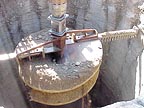

The purpose of the Department of Defense's Ground-based Midcourse Defense (GMD) program is to develop and potentially deploy an efficient, effective system that detects, tracks and destroys incoming missiles before they enter our atmosphere. The program is in its development phase. After the first three years of development, integration and testing, if the missile threat warrants it, the GMD system could be deployed and operational within five more years. If the missile threat does not warrant deployment, the development of an improved, more capable system would continue. If a decision is made to deploy during the continuing development, a GMD system can be deployed within five years.

The GMD system consists of integrated ground-based interceptors, kill vehicles, a variety of sensors and an expansive battle management command and control network, which is capable of protecting the homeland from attack.

“The progress made on the GMD program at the Fort Greely site over the past three years has been outstanding,” says Jim Albaugh, president and CEO of Boeing Integrated Defense Systems. “GMD is one of the first real system-of-systems programs and ranks among the most complex programs the country has ever undertaken. Addressing this national need has taken the best of industry and the best of Boeing.”
ND
Report Abusive Comment